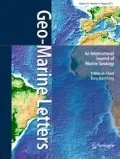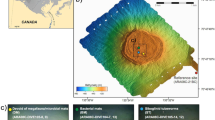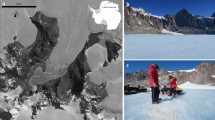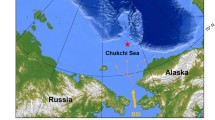Abstract
Distributions and carbon isotopic compositions of microbial lipid biomarkers were investigated in sediment cores from the G11 and G12 pockmarks in the Nyegga sector of the Storegga Slide on the mid-Norwegian margin to explore differences in depth zonation, type and carbon assimilation mode of anaerobic methane-oxidizing archaea (ANMEs) and associated sulphate-reducing bacteria responsible for anaerobic oxidation of methane (AOM) in these cold seep environments. While the G11 site is characterised by black reduced sediments colonized by gastropods and Siboglinidae tubeworms, the G12 site has black reduced sediments devoid of fauna but surrounded by a peripheral occurrence of gastropods and white filamentous microbial mats. At both sites, bulk sediments contained abundant archaeal and bacterial lipid biomarkers substantially depleted in 13C, consisting mainly of isoprenoidal hydrocarbons and dialkyl glycerol diethers, fatty acids and non-isoprenoidal monoalkylglycerol ethers. At the G11 site, down-core profiles revealed that lipid biomarkers were in maximum abundance from 10 cm depth to the core bottom at 16 cm depth, associated with δ13C values of −57 to −136‰. At the G12 site, by contrast, lipid biomarkers were in high abundance in the upper 5 cm sediment layer, associated with δ13C values of −43 to −133‰. This suggests that, as expected from the benthic fauna characteristics of the sites, AOM takes place mainly at depth in the G11 pockmark but just below the seafloor in the G12 pockmark. These patterns can be explained largely by variable fluid flow rates. Furthermore, at both sites, a dominance of ANME-2 archaea accompanied by their bacterial partners is inferred based on lipid biomarker distributions and carbon isotope signatures, which is in agreement with recently published DNA analyses for the G11 pockmark. However, the present data reveal high discrepancies in the contents and δ13C values for both archaeal and bacterial lipid profiles, implying the possible involvement of at least two distinct AOM-related microbial consortia at the inferred AOM depth zonation of G11 and G12 pockmark sediments. In both sediment cores, the δ13C profiles for most archaeal lipids suggest a direct assimilation of dissolved inorganic carbon (DIC) in addition to methane by ANMEs (chemoautotrophy); constant and highly depleted δ13C profiles for PMI:3, an archaeal lipid biomarker presumably related to ANME-2, suggest a direct assimilation of 13C-depleted methane-derived carbon via AOM (methanotrophy). Evidently, the common approach of investigating lipid biomarker contents and δ13C signatures in cold seep sediments does not suffice to precisely discriminate between the carbon assimilation mode for each ANME archaeal group and associated bacteria. Rather, this needs to be combined with further specific labelling studies including different carbon sources (methane carbon, methane-derived organic intermediates and DIC) in order to unravel the metabolic pathways of each microbial consortium involved in AOM (ANME-1 vs. ANME-2 vs. ANME-3 archaeal group and associated bacteria).





Similar content being viewed by others
References
Aloisi G, Bouloubassi I, Heijs SK, Pancost RD, Pierre C, Sinninghe Damsté JS, Gottschal JC, Forney LJ, Rouchy J-M (2002) CH4-consuming microorganisms and the formation of carbonate crusts at cold seeps. Earth Planet Sci Lett 203:195–203
Andreassen K, Mienert J, Bryn P, Singh SC (2000) A double gas-hydrate related bottom simulating reflector at the Norwegian continental margin. Ann N Y Acad Sci 912:126–135
Birgel D, Himmler T, Freiwald A, Peckmann J (2008) A new constraint on the antiquity of anaerobic oxidation of methane: Late Pennsylvanian seep limestones from southern Namibia. Geology 36:543–546
Blumenberg M, Seifert R, Reitner J, Pape T, Michaelis W (2004) Membrane lipid patterns typify distinct anaerobic methanotrophic consortia. Proc Natl Acad Sci U S A 101:11111–11116
Blumenberg M, Seifert R, Nauhaus K, Pape T, Michaelis W (2005) In vitro study of lipid biosynthesis in an anaerobically methane-oxidizing microbial mat. Appl Environ Microbiol 71:4345–4351
Blumenberg M, Krüger M, Nauhaus K, Talbot HM, Oppermann B, Seifert R, Pape T, Michaelis W (2006) Biosynthesis of hopanoids by sulfate-reducing bacteria (genus Desulfovibrio). Environ Microbiol 8:1220–1227
Boetius A, Ravenschlag K, Schubert C, Rickert D, Widdel F, Gieseke A, Amann R, Jørgensen BB, Witte U, Pfannkuche O (2000) A marine microbial consortium apparently mediating anaerobic oxidation of methane. Nature 407:623–626
Bouloubassi I, Aloisi G, Pancost RD, Hopmans E, Pierre C, Sinninghe Damsté JS (2006) Archaeal and bacterial lipids in authigenic carbonate crusts from eastern Mediterranean mud volcanoes. Org Geochem 37:484–500
Bouloubassi I, Nabais E, Pancost RD, Lorre A, Taphanel M-H (2009) First biomarker evidence for methane oxidation at cold seeps in the South East Atlantic (REGAB pockmark). Deep-Sea Res II 56:2239–2247
Cambon-Bonavita MA, Nadalig T, Roussel E, Delage E, Duperron S, Caprais J-C, Boetius A, Sibuet M (2009) Diversity and distribution of methane oxidizing microbial communities associated with different faunal assemblages in a giant pockmark of the Gabon continental margin. Deep-Sea Res II 56:2248–2258
Chatterjee S, Dickens GR, Bhatnagar G, Chapman WG, Dugan B, Snyder GT, Hirasaki GJ (2011) Pore water sulfate, alkalinity, and carbon isotope profiles in shallow sediment above marine gas hydrate systems: a numerical modeling perspective. J Geophys Res 116:B09103. doi:10.1029/2011JB008290
Chen Y, Ussler W, Haflidason H, Lepland A, Rise R, Hovland H, Hjelstuen BO (2010) Sources of methane inferred from pore water δ13C of dissolved inorganic carbon in Pockmark G11, offshore Mid-Norway. Chem Geol 275:127–138
Chen Y, BianY, Haflidason H, Matsumoto R (2011) Present and past methane seepage in pockmark CN03, Nyegga, offshore mid-Norway. In: Proc 7th Int Conf Gas Hydrates (ICGH 2011), 17–21 July 2011, Edinburgh. http://www.pet.hw.ac.uk/icgh7/papers/icgh2011Final00186.pdf
Chevalier N, Bouloubassi I, Stadnitskaia A, Taphanel M-H, Lorre A, Sinninghe Damsté J, Pierre C (2010) Distributions and carbon isotopic compositions of lipid biomarkers in authigenic carbonate crusts from the Nordic margin (Norwegian Sea). Org Geochem 41:885–890
Chevalier N, Bouloubassi I, Birgel D, Crémière A, Taphanel M-H, Pierre C (2011) Authigenic carbonates at cold seeps in the Marmara Sea (Turkey): a lipid biomarker and stable carbon and oxygen isotope investigation. Mar Geol 288:112–121
Chevalier N, Bouloubassi I, Birgel D, Taphanel M-H, Lopez-Garcia P (2013) Microbial methane turnover at Marmara Sea cold seeps: a combined 16 rRNA and lipid biomarker investigation. Geobiology 11:55–71
Decker C, Morineaux M, Van Gaever S, Caprais JC, Lichtschlag A, Gauthier O, Andersen AC, Olu K (2012) Habitat heterogeneity influences cold-seep macrofaunal communities within and among seeps along the Norwegian margin. Part 1: macrofaunal community structure. Mar Ecol 33:205–230
Elvert M, Niemann H (2008) Occurrence of unusual steroids and hopanoids derived from aerobic methanotrophs at an active marine mud volcano. Org Geochem 39:167–177
Elvert M, Suess E, Whiticar MJ (1999) Anaerobic methane oxidation associated with marine gas hydrates: superlight Cisotopes from saturated and unsaturated C20 and C25 irregular isoprenoids. Naturwissenschaften 86:295–300
Elvert M, Boetius A, Knittel K, Jørgensen BB (2003) Characterization of specific membrane fatty acids as chemotaxonomic markers for sulfate-reducing bacteria involved in anaerobic oxidation of methane. Geomicrobiol J 20:403–419
Elvert M, Hopmans EC, Treude T, Boetius A, Suess E (2005) Spatial variations of methanotrophic consortia at cold methane seeps: implications from a high-resolution molecular and isotopic approach. Geobiology 3:195–209
Foucher J-P, Westbrook GK, Boetius A, Ceramicola S, Dupré S, Mascle J, Mienert J, Pfannkuche O, Pierre C, Praeg D (2009) Structure and drivers of cold seep ecosystems. Oceanography 22:92–109
Hill TM, Paull CK, Critser RB (2012) Glacial and deglacial seafloor methane emissions from pockmarks on the northern flank of the Storegga Slide complex. Geo-Mar Lett 32:73–84
Hinrichs K-U, Boetius AB (2002) The anaerobic oxidation of methane: new insights in microbial ecology and biogeochemistry. In: Wefer G, Billett D, Hebbeln D, Jørgensen BB, Schlüter M, van Weering T (eds) Ocean margin systems. Springer, Heidelberg, pp 457–477
Hinrichs K-U, Hayes JM, Sylva SP, Brewer PG, DeLong EF (1999) Methane consuming archaebacteria in marine sediments. Nature 398:802–805
Hinrichs K-U, Summons RE, Orphan V, Sylva SP, Hayes JM (2000) Molecular and isotopic analysis of anaerobic methane-oxidizing communities in marine sediments. Org Geochem 31:1685–1701
Hjelstuen BO, Haflidason H, Sejrup H, Nygård A (2010) Sedimentary and structural control on pockmark development—evidence from the Nyegga Pockmark Field, NW European margin. Geo-Mar Lett 30:221–230
Hopmans EC, Schouten S, Pancost RD, Van der Meer MJT, Sinninghe Damsté JS (2000) Analysis of intact tetraether lipids in archaeal cell material and sediments by high performance liquid chromatography/atmospheric pressure chemical ionization mass spectrometry. Rapid Commun Mass Spectrom 14:585–589
Hovland M (1981) Characteristics of pockmarks in the Norwegian Trench. Mar Geol 39:103–117
Hovland M, Svensen H (2006) Submarine pingoes: indicators of shallow gas hydrates in a pockmark at Nyegga, Norwegian Sea. Mar Geol 228:15–23
Hovland M, Svensen H, Forsberg CF, Johansen H, Fichler C, Fosså JH, Jonsson R, Rueslåtten H (2005) Complex pockmarks with carbonate-ridges off mid-Norway: products of sediment degassing. Mar Geol 218:191–206
Huguet C, Hopmans EC, Febo-Ayala W, Thompson DH, Sinninghe Damsté JS, Schouten S (2006) An improved method to determine the absolute abundance of glycerol dibiphytanyl glycerol tetraether lipids. Org Geochem 37:1036–1041
Hustoft S, Mienert J, Bünz S, Nouzé H (2007) High-resolution 3D-seismic data indicate focussed fluid migration pathways above polygonal fault systems of the mid-Norwegian margin. Mar Geol 245:89–106
Hustoft S, Bünz S, Mienert J (2010) Three-dimensional seismic analyses of the morphology and spatial distribution of chimneys beneath the Nyegga pockmark field, offshore mid-Norway. Basin Res 22:465–480
Ivanov M, Westbrook GK, Blinova V, Kozlova E, Mazzini A, Nouzé H, Minshull TA (2007) First sampling of gas hydrate from the Vøring Plateau. Eos Trans AGU 88:209–216
Ivanov M, Mazzini A, Blinova V, Kozlova E, Laberg J-S, Matveeva T, Taviani M, Kaskov N (2010) Seep mounds on the Southern Vøring Plateau (offshore Norway). Mar Petrol Geol 27:1235–1261
Kellermann MY, Wegner G, Elvert M, Yukio Yoshinaga M, Lin YS, Holler T, Prieto Mollar X, Knittel K, Hinrichs K-U (2012) Autotrophy as a predominant mode of carbon fixation in anaerobic methane-oxidizing microbial communities. Proc Natl Acad Sci U S A 109:19321–19326
Knittel K, Boetius A (2009) Anaerobic oxidation of methane: progress with an unknown process. Annu Rev Microbiol 63:311–334
Knittel K, Boetius A, Lemke A, Eilers H, Lochte K, Pfannkuche O, Linke P, Amann R (2003) Activity, distribution, and diversity of sulfate reducers and other bacteria in sediments above gas hydrate (Cascadia margin, Oregon). Geomicrobiol J 20:269–294
Knittel K, Lösekann T, Boetius A, Kort R, Amann R (2005) Diversity and distribution of methanotrophic archaea at cold seeps. Appl Environ Microbiol 71:467–479
Koga Y, Akagawa-Matsushita M, Ohga M, Nishihara M (1993) Taxonomic significance of the distribution of component parts of polar ether lipids in methanogens. Syst Appl Microbiol 16:342–351
Koga Y, Morii H, Akagawa-Matsushita M, Ohga M (1998) Correlation of polar lipid composition with 16S rRNA phylogeny in methanogens. Further analysis of lipid component parts. Biosci Biotechnol Biochem 62:230–236
Lazar CS, Dinasquet J, L’Haridon S, Pignet P, Toffin L (2011) Distribution of anaerobic methane-oxidizing and sulfate reducing communities in the G11 Nyegga pockmark, Norwegian Sea. Anton Leeuw 100:639–653
Lösekann T, Knittel K, Nadalig T, Fuchs B, Niemann H, Boetius A, Amann R (2007) Diversity and abundance of aerobic and anaerobic methane oxidizers at the Haakon Mosby mud volcano, Barents Sea. Appl Environ Microbiol 73:3348–3362
Mazzini A, Svensen H, Hovland M, Planke S (2006) Comparison and implications from strikingly different authigenic carbonates in a Nyegga complex pockmark, G11, Norwegian Sea. Mar Geol 231:89–102
Meulepas RJW, Jagersma CG, Khadem AF, Buisman CJN, Stams AJM, Lens PNL (2009a) Effect of environmental conditions on sulfate reduction with methane as electron donor by an Eckernförde Bay enrichment. Environ Sci Technol 43:6553–6559
Meulepas RJW, Jagersma CG, Gieteling J, Buisman CJN, Stams AJM, Lens PNL (2009b) Enrichment of anaerobic methanotrophs in sulfate-reducing membrane bioreactors. Biotechnol Bioeng 104:458–470
Mienert J, Vanneste M, Haflidason H, Bünz S (2010) Norwegian margin outer shelf cracking: a consequence of climate-induced gas hydrate dissociation? Int J Earth Sci 99:207–225. doi:10.1007/s00531-010-0536-z
Nauhaus K, Albrecht M, Elvert M, Boetius A, Widdel F (2007) In vitro cell growth of marine archaeal-bacterial consortia during anaerobic oxidation of methane with sulfate. Environ Microbiol 9:187–196
Niemann H, Elvert M (2008) Diagnostic lipid biomarker and stable carbon isotope signatures of microbial communities mediating the anaerobic oxidation of methane with sulphate. Org Geochem 39:1668–1677
Niemann H, Lösekann T, De Beer D, Elvert M, Nadalig T, Knittel K, Amann R, Sauter EJ, Schlüter M, Klages M, Foucher J-P, Boetius A (2006a) Novel microbial communities of the Haakon Mosby mud volcano and their role as a methane sink. Nature 443:854–858
Niemann H, Duarte J, Hensen C, Omoregie E, Magalhães VH, Elvert M, Pinheiro LM, Kopf A, Boetius A (2006b) Microbial methane turnover at mud volcanoes of the Gulf of Cadiz. Geochim Cosmochim Acta 70:5336–5355
Omoregie EO, Niemann H, Mastalerz V, DeLange GJ, Stadnitskaia A, Mascle J, Foucher J-P, Boetius A (2009) Microbial methane oxidation and sulfate reduction at cold seeps of the deep Eastern Mediterranean Sea. Mar Geol 261:114–127
Orphan VJ, Hinrichs K-U, Ussler W, Paull CK, Taylor LT, Sylva SP, Hayes JM, Delong EF (2001) Comparative analysis of methane-oxidizing archaea and sulfate-reducing bacteria in anoxic marine sediments. Appl Environ Microbiol 67:1922–1934
Orphan VJ, House CH, Hinrichs K-U, Mckeegan KD, Delong EF (2002) Multiple archaeal groups mediate methane oxidation in anoxic cold seep sediments. Proc Natl Acad Sci U S A 99:7663–7668
Pancost RD, Sinninghe Damsté JS, de Lint S, van der Maarel MJEC, Gottschal JC, Medinaut Shipboard Scientific Party (2000) Biomarker evidence for widespread anaerobic methane oxidation in Mediterranean sediments by a consortium of methanogenic archaea and bacteria. Appl Environ Microbiol 66:1126–1132
Pancost RD, Bouloubassi I, Aloisi V, Sinninghe Damsté JS, the MEDINAUT Shipboard Scientific Party (2001a) Three series of non-isoprenoidal dialkyl glycerol diethers in cold-seep carbonate crests. Org Geochem 32:695–707
Pancost RD, Hopmans EC, Sinninghe Damsté JS, the MEDINAUT Shipboard Scientific Party (2001b) Archaeal lipids in Mediterranean cold seeps: Molecular proxies for anaerobic methane oxidation. Geochim Cosmochim Acta 65:1611–1627
Pancost RD, Zhang CL, Tavacoli J, Talbot HM, Farrimond P, Schouten S, Sinninghe Damsté JS, Sassen R (2005) Lipid biomarkers preserved in hydrate-associated authigenic carbonate rocks of the Gulf of Mexico. Palaeogeogr Palaeoclimatol Palaeoecol 227:48–66
Paull CK, Ussler W, Holbrook WS, Hill TM, Keaten R, Mienert J, Haflidason H, Johnson JE, Winters WJ, Lorenson TD (2008) Origin of pockmarks and chimney structures on the flanks of the Storegga Slide, offshore Norway. Geo-Mar Lett 28:43–51
Pernthaler A, Dekas AE, Brown CT, Goffredi SK, Embaye T, Orphan VJ (2008) Diverse syntrophic partnerships from deep-sea methane vents revealed by direct cell capture and metagenomics. Proc Natl Acad Sci U S A 105:7052–7057
Plaza-Faverola A, Bünz S, Mienert J (2010) Fluid distributions inferred from P-wave velocity and reflection seismic amplitude anomalies beneath the Nyegga pockmark field of the mid-Norwegian margin. Mar Petrol Geol 27:46–60
Plaza-Faverola A, Bünz S, Mienert J (2011) Repeated fluid expulsion through sub-seabed chimneys offshore Norway in response to glacial cycles. Earth Planet Sci Lett 305:297–308
Pohlman JW, Riedel M, Bauer JE, Canue EA, Paull CK, Lapham L, Grabowski KS, Coffin RB, Spence GD (2013) Anaerobic methane oxidation in low-organic content methane seep sediments. Geochim Cosmochim Acta 108:184–201
Reeburgh WS (2007) Oceanic methane biogeochemistry. Chem Rev 107:486–513
Reiche S, Hjelstuen BO, Haflidason H (2011) High-resolution seismic stratigraphy, sedimentary processes and the origin of seabed cracks and pockmarks at Nyegga, mid-Norwegian margin. Mar Geol 284:28–39
Roalkvam I, Jørgensen SL, Chen Y, Stokke R, Dahle H, Hocking WP, Lanzén A, Haflidason H, Steen IH (2011) New insight into stratification of anaerobic methanotrophs in cold seep sediments. FEMS Microbiol Ecol 78:233–243
Roalkvam I, Dahle H, Chen Y, Jørgensen SL, Haflidason H, Steen IH (2012) Fine-scale community structure analysis of ANME in Nyegga sediments with high and low methane flux. Front Microbiol 3:216. doi:10.3389/fmicb.2012.00216
Rohmer M, Bouvier-Nave P, Ourisson G (1984) Distribution of hopanoid triterpenes in prokaryotes. J Gen Microbiol 130:1137–1150
Rossel PE, Elvert M, Ramette A, Boetius A, Hinrichs KU (2011) Factors controlling the distribution of anaerobic methanotrophic communities in marine environments: evidence from intact polar membrane lipids. Geochim Cosmochim Acta 75:164–184
Schouten S, Hopmans EC, Sinninghe Damste JS (2013) The organic geochemistry of glycerol dialkyl glycerol tetraether lipids: a review. Org Geochem 54:19–61
Stadnitskaia A, Muyzer G, Abbas B, Coolen MJL, Hopmans EC, Bass M, van Weering TCE, Ivanov MK, Poludetkina E, Sinninghe Damsté JS (2005) Biomarker and 16S rDNA evidence for anaerobic oxidation of methane and related carbonate precipitation in deep-sea mud volcanoes of the Sorokin Trough, Black Sea. Mar Geol 217:67–96
Stadnitskaia A, Nadezhkin D, Abbas B, Blinova V, Ivanov MK, Sinninghe Damsté JS (2008a) Carbonate formation by anaerobic oxidation of methane: evidence from lipid biomarker and fossil 16S rDNA. Geochim Cosmochim Acta 72:1824–1836
Stadnitskaia A, Bouloubassi I, Elvert M, Hinrichs K-U, Sinninghe Damsté JS (2008b) Extended hydroxyarchaeol, a novel lipid biomarker for anaerobic methanotrophy in cold seepage habitats. Org Geochem 39:1007–1014
Thiel V, Peckmann J, Reitner J, Seifert R, Wehrung P, Michaelis W (1999) Highly isotopically depleted isoprenoids – molecular markers for ancient methane venting. Geochim Cosmochim Acta 63:3959–3966
Vaular EN, Barth T, Haflidason H (2010) The geochemical characteristics of the hydrate-bound gases from the Nyegga pockmark field, Norwegian Sea. Org Geochem 41:437–444
Wakeham SG, Lewis CM, Hopmans EC, Schouten S, Sinninghe Damsté JS (2003) Archaea mediate anaerobic oxidation of methane in deep euxinic waters of the Black Sea. Geochim Cosmochim Acta 67:1359–1374
Wegener G, Niemann H, Elvert M, Hinrichs K-U, Boetius A (2008) Assimilation of methane and inorganic carbon by microbial communities mediating the anaerobic oxidation of methane. Environ Microbiol 10:2287–2298
Westbrook GH, Exley R, Minshull TA, Nouzé H, Gailler A, Jose T, Ker S, Plaza A (2008) High-resolution 3D seismic investigations of hydrate-bearing fluid-escape chimneys in the Nyegga region of the Vøring Plateau, Norway. In: Proc 6th Int Conf Gas Hydrates (ICGH 2008), 6–10 July 2008, Vancouver. http://hdl.handle.net/2429/1175
Acknowledgments
This work was supported by the HERMES project funded by the European Commission’s Framework Six Programme, EC contract no. GOCE-CT-2005-511234, by a grant from the Ministry of Education (France) to Nicolas Chevalier, and by a VENI grant from the Netherlands Organization for Scientific Research (NWO) to Alina Stadnitskaia. We thank the scientific team of the VICKING cruise, the captain and crew of the R/V Pourquoi pas?, and Catherine Pierre for sediment sampling. Also gratefully acknowledged are the technical and scientific staff of the Department of Marine Organic Biogeochemistry at NIOZ. Constructive assessments by three anonymous reviewers and the editors proved useful in improving the paper.
Author information
Authors and Affiliations
Corresponding author
Additional information
Responsible guest editor: C. Pierre
Electronic supplementary material
Below is the link to the electronic supplementary material.
ESM 1
(PDF 329 kb)
Rights and permissions
About this article
Cite this article
Chevalier, N., Bouloubassi, I., Stadnitskaia, A. et al. Lipid biomarkers for anaerobic oxidation of methane and sulphate reduction in cold seep sediments of Nyegga pockmarks (Norwegian margin): discrepancies in contents and carbon isotope signatures. Geo-Mar Lett 34, 269–280 (2014). https://doi.org/10.1007/s00367-014-0363-5
Received:
Accepted:
Published:
Issue Date:
DOI: https://doi.org/10.1007/s00367-014-0363-5




